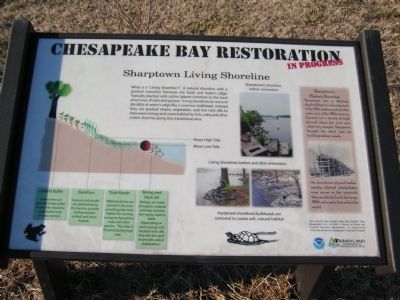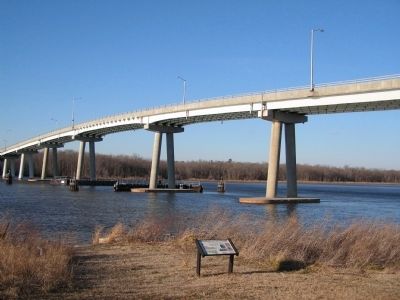Sharptown in Wicomico County, Maryland — The American Northeast (Mid-Atlantic)
Chesapeake Bay Restoration in Progress
Sharptown Living Shoreline
Upland Buffer
Native trees are planted in the buffer to provide shoreline stabilization and erosion control.
Bankface
Grasses and shrubs are planted along the bank to provide further erosion control and some habitat.
Tidal Marsh
Wetland plants are placed in this area providing the most habitat for nesting terrapins, horseshoe crabs and other species. This area is flooded during high tide.
Biolog and Rock Sill
Biologs are made of organic material and help stabilize the newly created bank.
Depending on wave energy and location rock sills may also be used to provide added stabilization.
(sidebar)
Sharptown's Historic Shoreline
Sharptown was a thriving shipbuilding town during most of the 19th century and into the early part of the 20th century. Located on a stretch of high ground where the river runs relatively straight, Sharptown became the ideal spot for building sailing vessels.
An abundance of good lumber nearby allowed shipbuilders easy access to the materials they needed to build the large, 100ft. schooners that sailed the world.
This project was funded under the Coastal Zone Management Act, by NOAA's Office of Ocean and Coastal Resource Management, in conjunction with the Maryland Chesapeake & Coastal Program
Erected by Maryland Department of Natural Resources, NOAA.
Topics. This historical marker is listed in these topic lists: Environment • Waterways & Vessels.
Location. 38° 32.676′ N, 75° 43.142′ W. Marker is in Sharptown, Maryland, in Wicomico County. Marker can be reached from Railway Street, 0.1 miles north of Little Water Street. This marker is located within Cope Bennett Park. Touch for map. Marker is at or near this postal address: 102 Railway St, Sharptown MD 21861, United States of America. Touch for directions.
Other nearby markers. At least 8 other markers are within 5 miles of this marker, measured as the crow flies. Sharptown War Memorial (approx. ¼ mile away); Veterans Memorial (approx. 0.4 miles away); San Domingo School Community & Cultural Center (approx. 2.3 miles away); San Domingo School
(approx. 2.6 miles away); "Rehoboth" (approx. 4.7 miles away); Mount Pleasant Methodist Church (approx. 4.9 miles away in Delaware); Portsville United Methodist Church (approx. 5.1 miles away in Delaware); Woodland United Methodist Church (approx. 5.1 miles away in Delaware). Touch for a list and map of all markers in Sharptown.
More about this marker. On the left is a diagram of the shoreline depicting "Mean High Tide" and "Mean Low Tide".
On the right are photographs of "Sharptown's shoreline, before restoration" and "Living Shorelines before and after restoration" with the caption, "Hardened shorelines/bulkheads are removed to create soft, natural habitat".
Credits. This page was last revised on January 19, 2021. It was originally submitted on January 22, 2011, by Nathan Davidson of Salisbury, Maryland. This page has been viewed 473 times since then and 4 times this year. Photos: 1, 2. submitted on January 22, 2011, by Nathan Davidson of Salisbury, Maryland. • Bernard Fisher was the editor who published this page.

